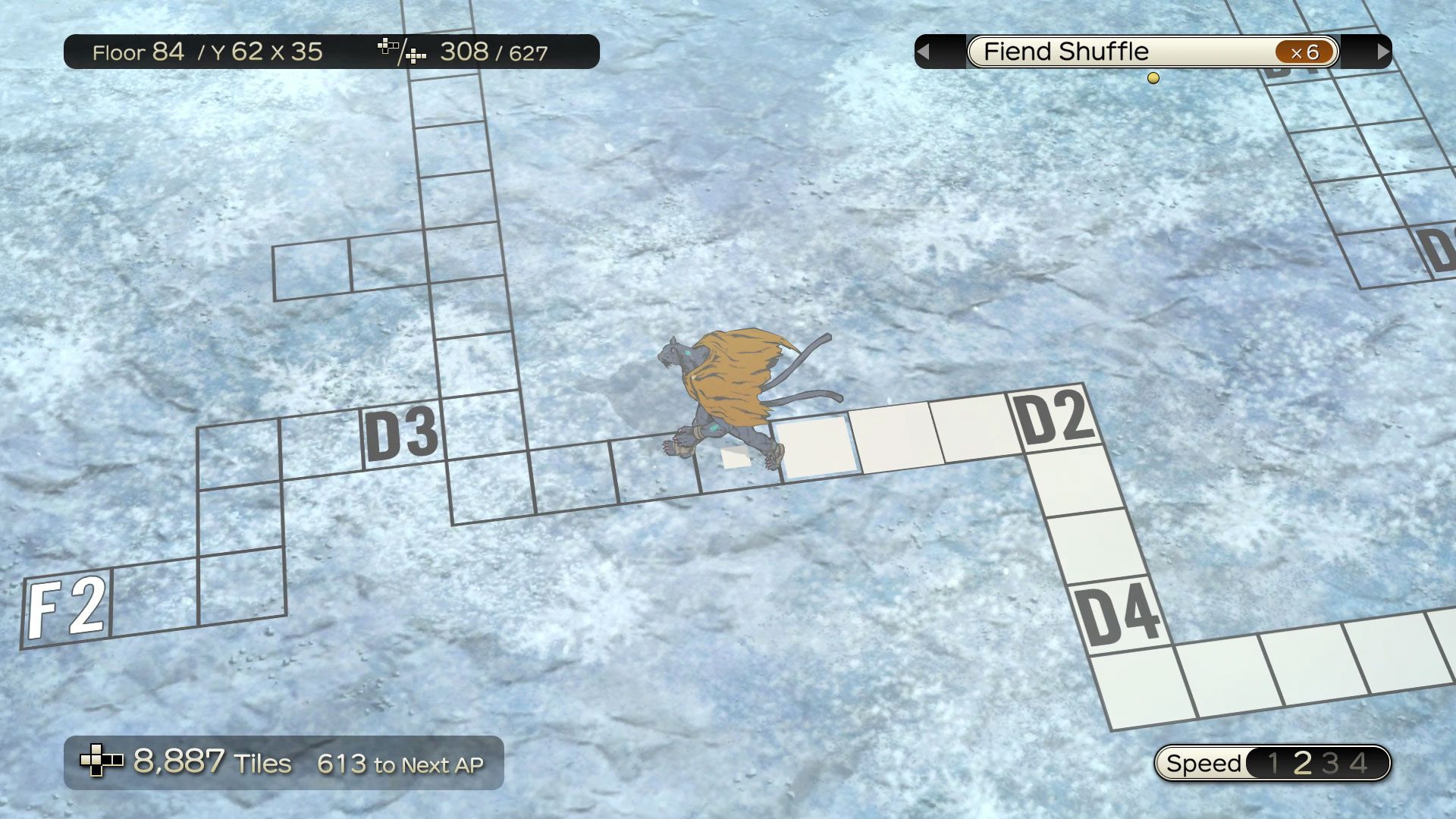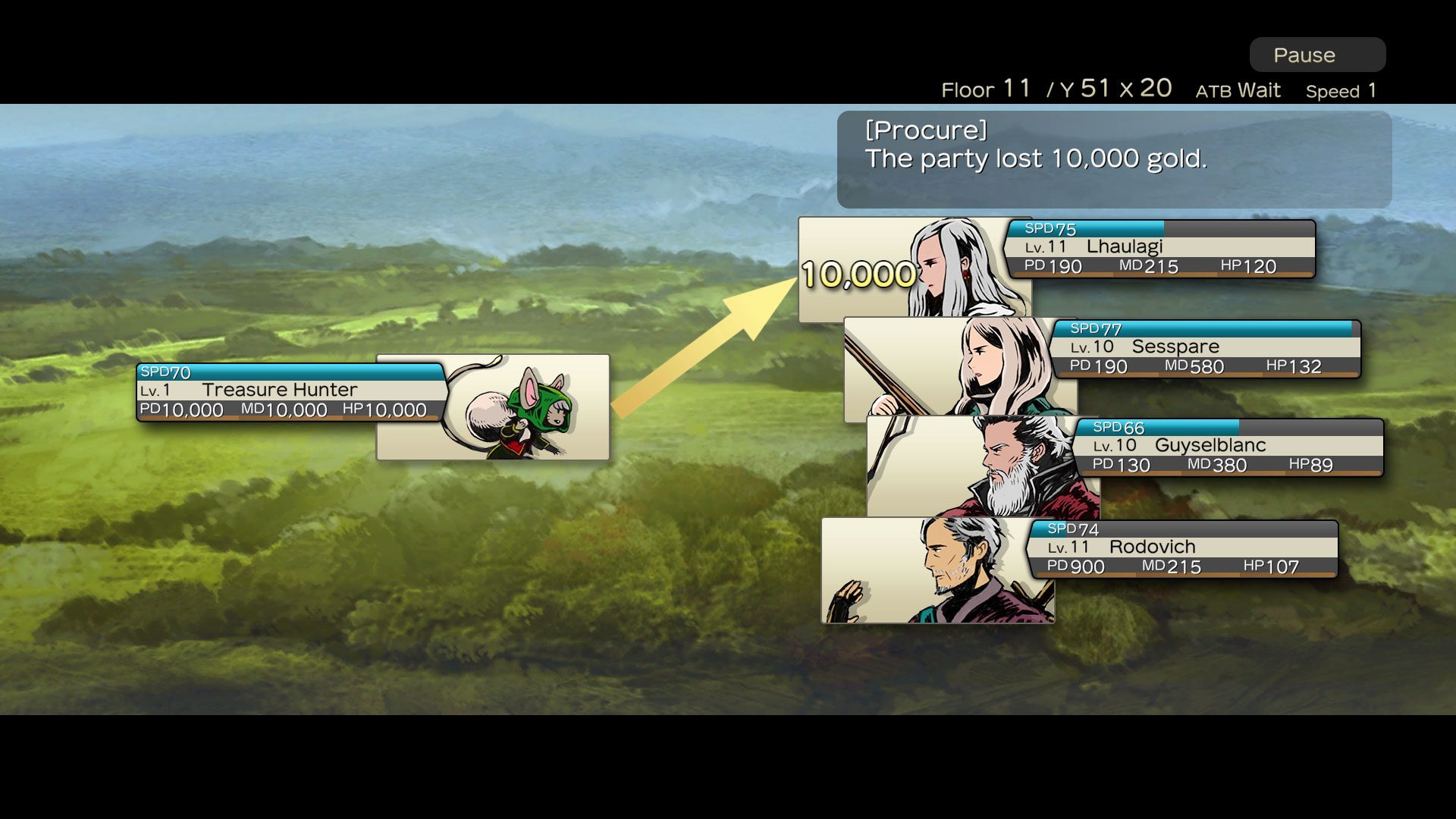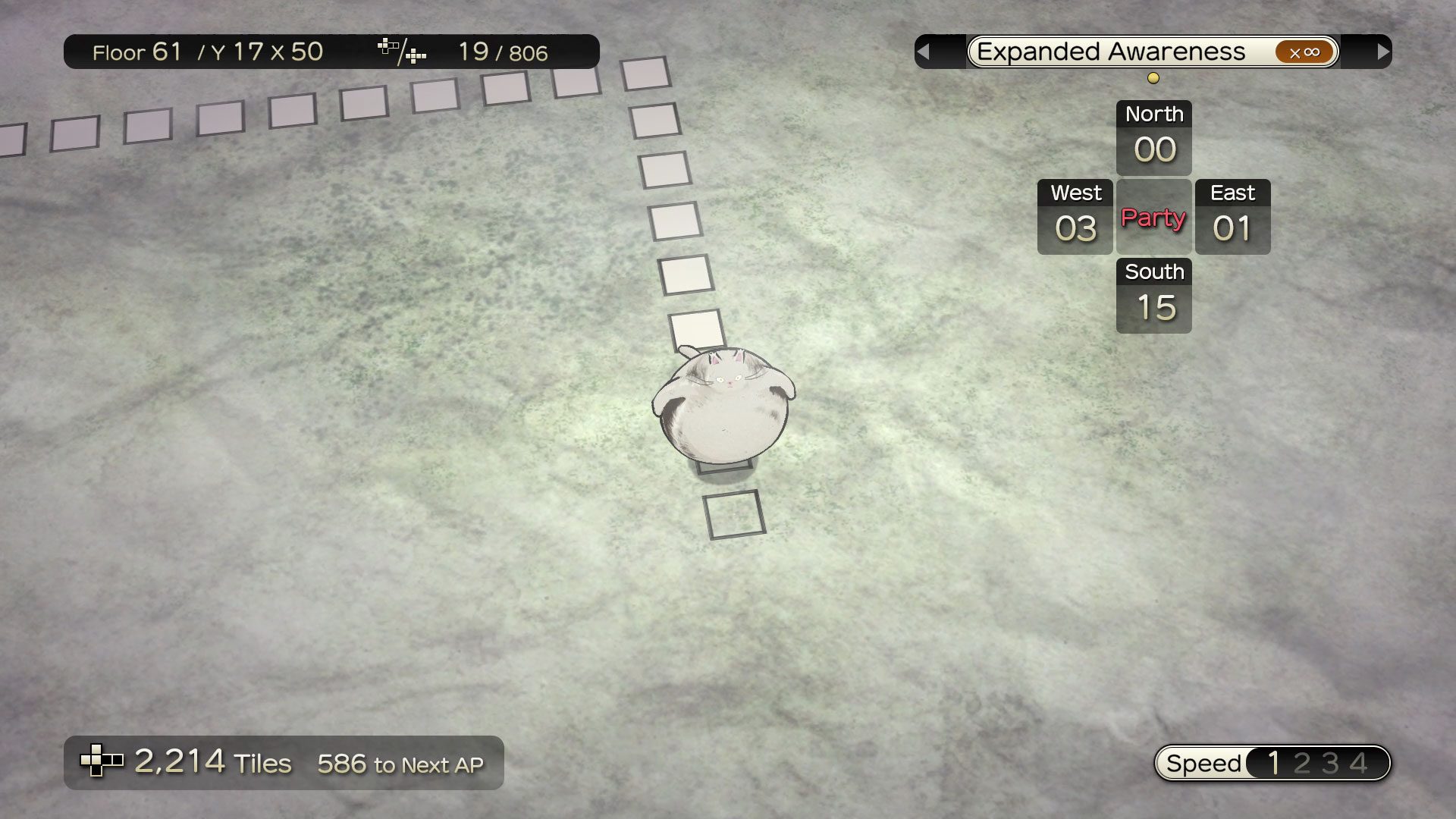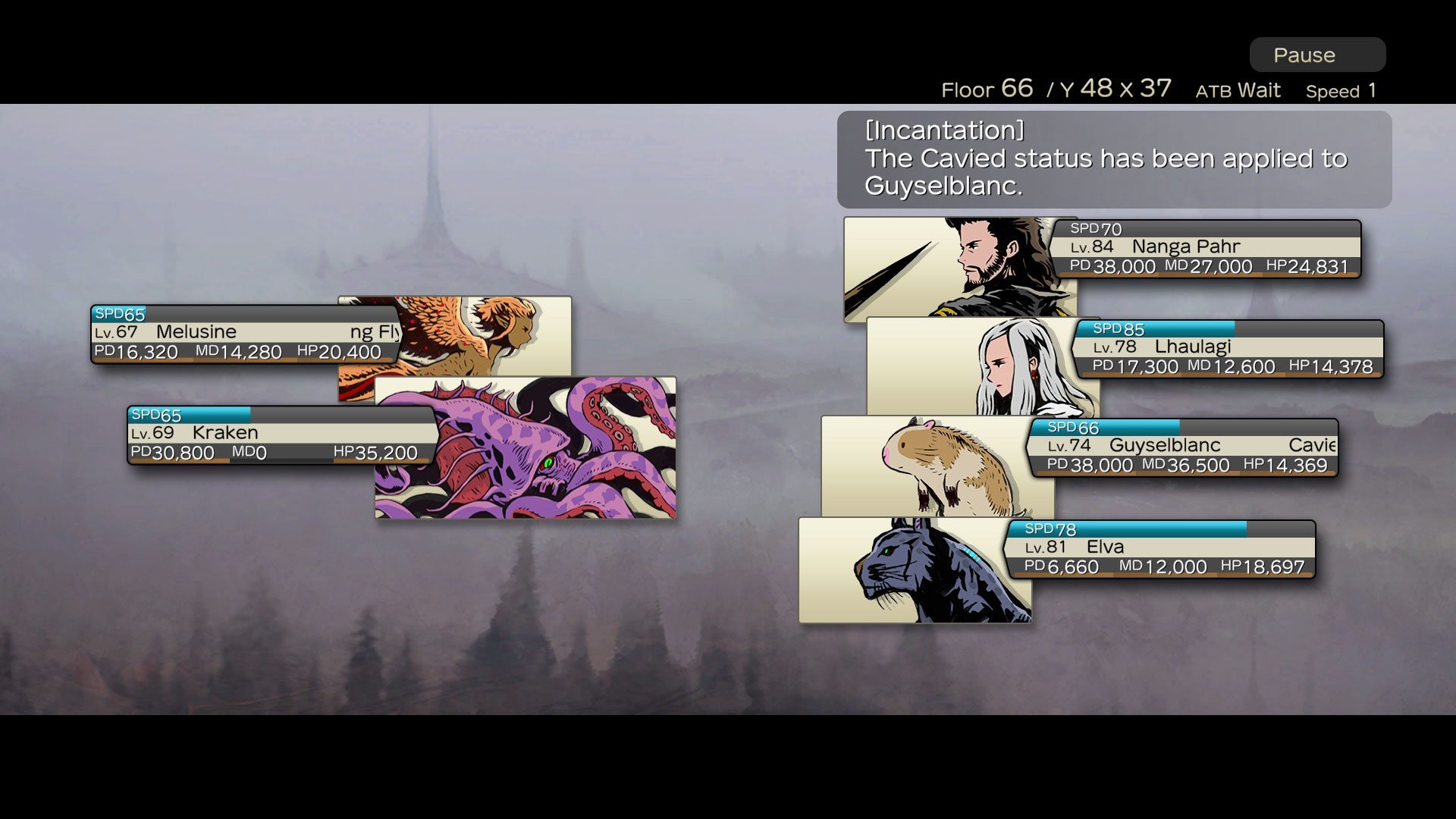Encounter? I hardly know her!
I wasn’t quite sure what to make of Dungeon Encounters when Square Enix announced it, real casual like, at Tokyo Game Show earlier this month. It was intriguing, of course, but I wasn’t sure exactly how much fun there was to be had in a game where you’re just walking across a pre-drawn barebones grid as you work your way down 99 floors.
Turns out there is a lot of fun to be had.

Dungeon Encounters (PC, PS4 [reviewed on PS5], Switch)
Developer: Square Enix
Publisher: Square Enix
Released: October 14, 2021
MSRP: $29.99
Dungeon Encounters is the brainchild of Director Hiroyuki Ito and Producer Hiroaki Kato. Both men are long-standing Square Enix developers, with Kato working on games like Tactics Ogre and the Final Fantasy Advance titles, and Ito cutting his teeth on Final Fantasy VI, IX, and XII; arguably the best games in the franchise. Ito is also the father of the Active Time Battle (ATB) system, a revolutionary idea introduced in Final Fantasy IV that significantly altered the trajectory of the turn-based RPG genre.
In the Final Fantasy series, the ATB system always worked in tandem with the other elements of the games — the characters, the plot, the setting, the graphics — to create the memorable experiences known and loved the world over. In Dungeon Encounters, it’s the main star. Everything else here has been stripped of its excess to just the necessities. The story is short enough to fit onto a single screen, character and enemy portraits are only half-drawn at best, the map is just a simple grid on different hues of parchment, and, while there are short backstories for each character, they’re inconsequential. All that matters here is the player’s understanding of the ATB system and their ability to navigate all 99 floors of this dungeon.
When you first begin Dungeon Encounters, you’ll create a team of up to four characters from those available at the Academy located on the top floor of the dungeon. It really doesn’t make much of a difference who you pick because there are no classes to worry about in this game and, if you’re anything like me, your initial party will get wiped within the first 20 floors. You’ll start with no money, but each party member will come equipped with weak weapons and armor. That’s all you get before you take your first steps toward the dangers below.
Each dungeon floor is pre-mapped, with every available encounter telegraphed in advance. Squares with white text hold something helpful for you, like a shop, information on an enemy, a healing point, or a puzzle. Squares with black text contain an enemy encounter. When you engage in a battle, the information on what you fought is recorded in the game’s compendium. This is extremely helpful because the text dictates what you will find in that space. If you see the numbers 05 in white, that always means that space is a resurrection point. If you fight a battle on a square with the black text 4D, you can proceed with confidence the next time you encounter a 4D square, as you’ll be fighting against the same enemy types. Having access to that compendium is like having the rulebook for the game at your disposal at all times.
Each dungeon floor is laid out on the x-y axis with the floor number acting as its z-axis coordinate. You should probably have a piece of paper and pen at your disposal because while you don’t have to worry about charting anything in this game, you will want to keep track of coordinates that serve as the answer to puzzle solutions or spaces you’ll need to access from above or below. You’ll also want to make sure you’re stepping on every square on the map, even the ones on those deep dungeon floors that negatively impact you the moment you land on them. The more squares you step on, the more Ability Points you’ll earn. These points are used to activate abilities your party can deploy in and out of battle.
Speaking of the battles, be prepared for a very fast-paced game. Enemies you encounter will consistently do high amounts of damage, so you’ll want to get in and out of these encounters as quickly as possible. That means making sure your party has high speed stats and is equipped with the best possible attacks.

Each member of your party can be equipped with two attacks. There is no shield or block option here or items for healing, meaning you only have to focus on doing damage. There are two types of attacks: physical and magic. These attacks are further subcategorized by whether they hit one enemy or the entire opposing party and if they do a set amount of damage or a fluctuating amount of damage with some pretty serious risk-reward. A Malio 5 magic attack, for example, always does 1,250 damage points, but a Malaflux 5 magic attack can do upwards of 2,000 damage points. It can also do seven damage points. That’s the gamble you take. If you’re thinking that it’s probably better to play it safe with the guaranteed amounts, know that the enemies you face love those fluctuating damage points.
The physical and magic attack types correspond to the two types of defenses all characters and enemies have. When you strike a monster with a physical attack, it drains their Physical Defense (PD). If you can whittle that all the way down, you’ll then be able to start chipping away at their HP, but only if you continue to use physical attacks. If you eliminate the PD of an enemy and then hit it with a magic attack, that will take away from its Magical Defense (MD) instead of its HP. Also, it’s important to note that you cannot hit either PD or MD and the HP in one attack. If your opponent has 12 points of PD left and your attack does 100 points in damage, it’s only going to drain those 12 points. The excess attack damage is not applied to their HP.
The enemies found throughout the dungeon floors have a wide array of values for their PD, MD, and HP. Some are front-loaded with massive amounts of PD and MD, but only 1 HP. Others might have no PD or MD at all, allowing you to strike at their large pool of HP with whatever are the most powerful attacks you have. You’ll also want to be aware of exactly what type of attack you have equipped. Flying enemies can’t be hit with physical attacks like swords or javelins, so you better make sure you have a crossbow or gun equipped to at least one character. Magic attacks can hit virtually any enemy, but you have to be aware if you’re facing a foe that can reflect magic back at you.

My experience up to this point with the ATB system is one of limitless options. In Final Fantasy games, you have so many attacks, spells, and items at your disposal that you can really do no wrong. It is refreshing to see that same brilliant battle system streamlined in the way it is in Dungeon Encounters. With fewer options at hand, I’m don’t spend so much time trying to figure out what I should do. I just act instinctively, which is why preparation before you enter a battle is so important. With just two attacks available, one armor slot, one helmet slot, and one accessory slot, I really had to get creative with the makeup of my team. I put more consideration here into what I equipped to each party member than I have any Final Fantasy game that uses ATB. Floor after floor, I would experiment with new tools as I collected them, switching up my team’s equipment for a little trial and error. Some experiments were instant successes. Others…not so much. After playing so many games that gently guide you through their world or give you an overabundance of tools to win, it was invigorating to really have to fend for myself here. And if you truly hate the ATB system, you can, as I did in the video above, switch it to “Wait” mode to play it more like a standard turn-based game.
As I mentioned earlier, some of the abilities you unlock can be used in battle, such Restoration, which completely heals the HP of one party member, or Desperate Strength, which greatly increases the attack power of a weary character. It’s important to note that outside of battle, you have very few options on how you can restore HP or revive a fallen comrade. PD and MD reset after each encounter, but if your team is running low on health, you may need to venture back to the last square with a white 06 on it to heal them up rather than risk it going forward. Because if your whole team is knocked out, it’s going to take some work to get back to where they are.
There are a lot of interesting ideas in this game that I absolutely love. You can go into debt if an enemy steals more cash than you have. If a party member is petrified, you have to leave them at that spot in the dungeon until you can find an altar to remove the petrification. And once you do that, you have to venture back to where you left them if they are to rejoin your team. And if your squad loses in a fight, you’ll start back at the top of the dungeon with whatever characters you have left at the Academy. If there are no characters in the Academy and you fall in battle, that is a complete game over. And don’t think it’s easy to cheese the save files. Dungeon Encounters saves automatically when you quit the game, when you go into a battle, and when you lose a battle. If you see your team is about to fall and exit out, when you restart the game, you’ll be right back at the beginning of that fight.

In retrospect, having my first team wiped out was the best thing to happen to me. That first go at running through the game, I was really nervous and proceeded with great trepidation, not knowing how difficult the journey would be. When that team fell and I started a rescue mission with my second squad — because you can revive your original team if you reach the spot where they fell — I was loaded not only with knowledge but also any weapons my first team had in their bag and the abilities they unlocked along the way. As I worked my way down the second time, I found the spots on the map I had missed that served as solutions to the puzzles. I also rescued other travelers lost in the dungeon to add my team or take back to the Academy in case I needed a third group of heroes to finish out the quest.
All of this knowledge, from my various attempts and everything I unlocked in the compendium, helped make each dungeon run more successful than the one before it. It also got me to pay attention to the creative strategic options I have to avoid confrontations or easily secure victory. When you know what an enemy encounter is beforehand, you can decide if you’re in a position to attempt it or not. If your team is running low on HP, you can use a few of your abilities to get around encounters until you find a healing point or work your way back to the last one you passed. Or, depending on the abilities you have, maybe it’s better to keep your HP low if it means doing more damage. Trying to figure out that perfect balance of risky behavior and surefire strategy is a huge part of why I love this game as much as I do.
I would be remiss if I didn’t mention the game’s music, which was overseen by Final Fantasy mainstay Nobuo Uematsu. Admittedly, there is very little music to be found here. When you’re in the overworld, all you get are the ambient sounds of whatever ecosystem you’re supposed to be in. Most of the game’s music is limited to the battles, and this soundtrack is an interesting mix of classical music, like Mussorgsky’s “Night on Bald Mountain,” recorded with a more hard rock/metal edge. I like the music and its old-school mentality, I just wish there was more of it. These songs start to lose their luster when I have to listen to the same track floor after floor after floor until I hit a new biome. More variety in the music, as well as the enemy portraits that are similarly limited, would be appreciated. But really, that’s the only complaint I can muster about this odd odyssey through the underground.
Dungeon Encounters is one of the best games I’ve played this year. I get that may be kind of hard to believe given its stripped-down presentation. After all, this isn’t exactly the type of game we expect to come from Square Enix, a developer that is no stranger to extravagant graphics and battle systems. But if you’re judging it on looks alone, you’re really not going to be able to see the rewarding dungeon crawler found within. Give it a shot, and once you get into it, you might see it the way I do: as a gripping, strategic adventure that is not only a game but a celebration of one of the great innovations of the turn-based RPG genre.
[This review is based on a retail build of the game provided by the publisher.]














Published: Oct 31, 2021 04:00 am